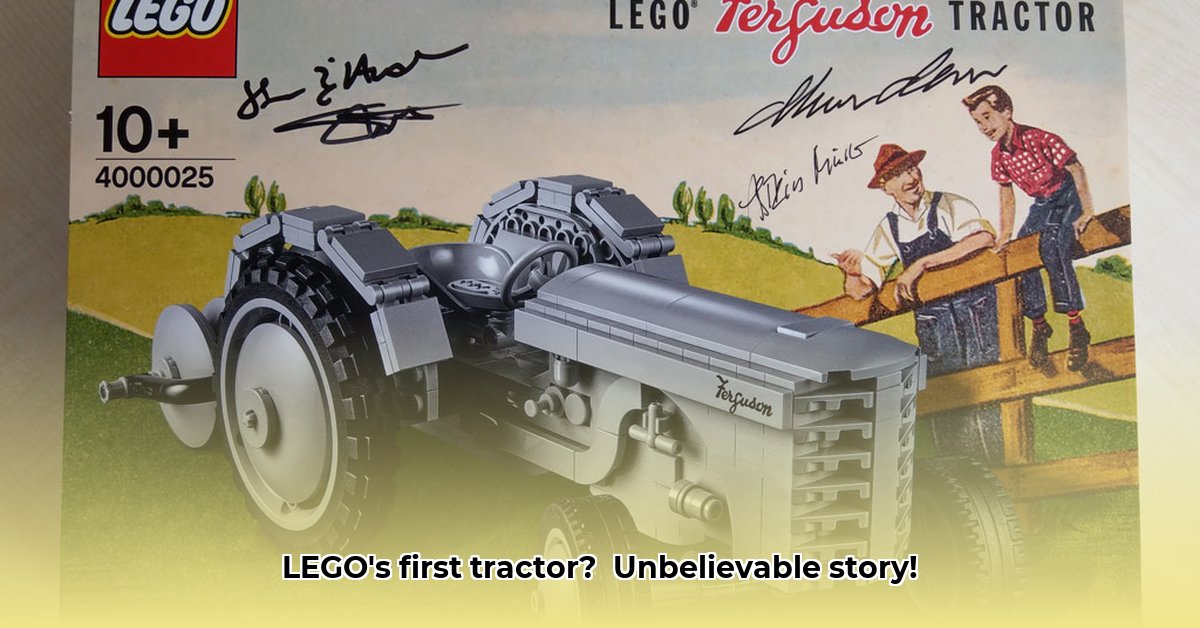
A Tiny Tractor, a Giant Leap for LEGO
The year is 1951. LEGO, then primarily a wooden toy manufacturer, launched a product that would irrevocably alter its trajectory: a meticulously detailed miniature replica of the iconic Ferguson TE-A tractor. This wasn't just another toy; it was a pivotal moment, a turning point that propelled LEGO from a regional player to a global powerhouse. Its success wasn't merely financial; it fundamentally changed LEGO's manufacturing process and laid the groundwork for its innovative building system. This seemingly simple toy was, in fact, a microcosm of the post-war agricultural boom and the subsequent technological advancements that reshaped Danish society. Did you know that approximately 100,000 units were sold within a few short years? That was an astonishing figure for the era. For more on similar LEGO tractors, check out this John Deere LEGO Tractor.
Ferguson Tractor LEGO: 1951's Toy Revolution
This seemingly simple toy—a meticulously crafted miniature of the Ferguson TE-A tractor—became a phenomenal success, selling an estimated 100,000 units within a few years. This wasn't just a financial windfall; it was a catalyst for innovation. The substantial profits directly fueled LEGO's ambitious transition from wooden to plastic toys, a pivotal decision that would redefine the company's future. This transition, largely completed by 1952, signaled a daring leap into modern manufacturing and played a crucial role in the evolution of the iconic LEGO brick.
From Wooden Wonders to Plastic Powerhouses: A Material Transformation
The success of the Ferguson tractor provided the financial resources for LEGO's boldest move yet: the complete transition from wood to plastic. This wasn't simply a change in material; it represented a fundamental shift in LEGO's manufacturing capabilities and product design philosophy. Plastic offered a level of detail and consistency that wood couldn't match, resulting in a more durable and aesthetically pleasing toy. This transformation, enabled by the profits from the Ferguson tractor, would dramatically improve the quality and playability of LEGO products. This decision, while seemingly simple, would forever shape LEGO's identity and its place in toy history.
Investing in the Future: A Legacy Forged in Plastic
The profits generated by the Ferguson tractor were wisely reinvested, leading to several critical advancements. These investments directly improved the quality of the "Automatic Binding Bricks" (later renamed "LEGO Mursten"), enhancing their durability and interlocking capabilities. This directly contributed to the development of the groundbreaking "LEGO System in Play" in 1955, a system that allowed for unprecedented levels of creativity and building possibilities. The success of the Ferguson tractor, therefore, wasn't just a standalone achievement; it was the springboard for a series of innovations that established LEGO's global dominance.
More Than Just a Toy: A Piece of LEGO History
The LEGO Ferguson tractor transcends its status as a mere toy; it’s a powerful symbol of LEGO's innovative spirit and strategic acumen. It represents a pivotal moment in the company's history, marking a decisive shift towards plastic manufacturing and laying the foundation for its globally recognized building system. Even today, the impact of the original Ferguson tractor continues to be felt, influencing LEGO's product development and shaping its enduring legacy.
A Lasting Legacy: The Enduring Impact of a Tiny Tractor
The influence of the LEGO Ferguson tractor is undeniable. It’s a testament to the transformative power of innovation and strategic investment. This small, seemingly insignificant toy became a pivotal catalyst for LEGO's growth, its success directly impacting the evolution of the LEGO brick and the development of its iconic building system. The story highlights the potential for even small-scale successes to generate significant long-term impact.
A Timeline of Triumph: Marking the Milestones
| Year | Milestone | Impact |
|---|---|---|
| 1951 | LEGO Ferguson tractor launched | Exceptional sales, substantial revenue boost |
| 1952 | Transition from wood to plastic toys | Revolutionized LEGO manufacturing & product quality |
| 1953 | "Automatic Binding Bricks" renamed "LEGO Mursten" | Improved brick design, enhanced play experience |
| 1955 | Introduction of the LEGO System in Play | Laid the groundwork for LEGO's iconic building system |
The success of the LEGO Ferguson tractor serves as a compelling case study in the power of innovation, strategic investment, and a keen understanding of market trends. It's a remarkable testament to the incredible impact a seemingly simple toy can have on a company's trajectory, and a reminder that sometimes the smallest innovations lead to the most profound transformations.